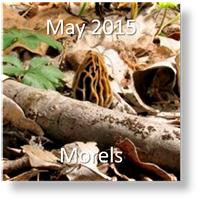
In spring, people flock to the woodlands of Illinois to enjoy the beauty of wildflowers, to hunt wild turkeys (
Meleagris gallopavo) and to search for morels. What are morels, and why do people want them?
Morels are types of fungi. When talking about more than one type of these organisms, you say "fungi." When talking about only one type of them, then "fungus" is used. The fungi are living things that absorb food from their surroundings, such as wood, soil, plants and animal wastes. They cannot make their own food or seek and capture food as some animals do.
The body of a fungus is generally hidden from us. It grows in the soil, rotten wood or other substrate. It is known as the mycelium and is made of thin filaments called hyphae. If you happen to be looking through rotten wood and see some tiny white strands growing in it, chances are good that you are looking at the body of a fungus. The mycelium of a fungus may cover a huge area.
The part of a fungus that you are probably familiar with is one of the reproductive structures. These only appear when conditions are favorable for their formation. They arise, produce spores and then disintegrate. Spores are one-celled structures that can start a new fungus. They are used to help the fungus spread to new locations and to survive when conditions are bad for growth. There are other reproductive structures in fungi, too, but you know enough now to help you understand morels.
Morels are in the sac fungi classification group. These fungi produce spores in a layer usually on the upper or outer surface of the cap. When the spores are mature, the sac containing them opens, and wind or rain can move them to a new location.
The sac fungi group contains a specific family known as sponge mushrooms. Morels are in this group. Most of them have a spongelike or bell-shaped cap. There is an exception, and we will discuss the "cup morel" below. Morels tend to be cream to brown in color. Their stalk is hollow or contains white, cottony strands.
There are several types of morels. Cup morels grow in woodland soil. They do not have a stalk, and their cap is flattened, like a disc. The following morels have a cap with deep pits that provide the spongy look: narrowhead morel; black morel; thick-footed morel; common or yellow morel; half-free morel; early morel; and bell morel. These appear in spring in woodland areas. The common morel grows in grassy areas and old orchards, too.
People like morels so much because they are good to eat. They are also fun to find. The three main types that people look for are the common or yellow morel, the black morel and the half-free morel. A word of caution is in order for anyone who finds mushrooms, including morels. If you cannot positively identify a mushroom, do not eat it. Even though distinctive in appearance, there are some other fungi that resemble morels, and they should not be eaten. All morels should be thoroughly cooked before being eaten. For those adults who may be reading this information, morels can cause poisoning, especially if consumed along with alcoholic beverages.
Black morels (Morchella elata) are the earliest morels to appear in Illinois each year. They may pop up as early as mid-March in southern Illinois. They have a dark cap. The cap does not hang free where it meets the stalk, and the stalk is hollow.
The common or yellow morel (Morchella elata) has a gray or yellow cap on a hollow stem. The cap connects directly with the stem. These morels start appearing in early April in southern Illinois.
Half-free morels (Morchella semilibera) have this name because the lower edge of the cap is not connected to the stalk. The hollow spaces on the cap are more like vertical divisions than the pits on the caps of the black and common morels. The stalk is hollow and may contain granules.
Before hunting morels, you must ask permission from the property owner and follow any rules for the site. We cannot cover all of the guidelines for every property owner in this article. In Illinois, it is legal to search for morels in state parks, but the morels must be for personal use only and cannot be sold. You must also follow site-specific rules. For example, on state parks where wild turkey hunting is allowed, you will not be able to start looking for morels until after 1:00 p.m. It is not legal to take morels from Illinois Nature Preserves.
Where should you look for morels in woodlands? It's difficult to say. Sometimes they seem to be associated with certain tree species, and other times they are not. They may appear year after year in the same location then the next year they may be absent. The fun of finding morels is discovering them and making your own theories to test in the years to come. Once you find a morel, you'll be back again and will have stories to tell!

